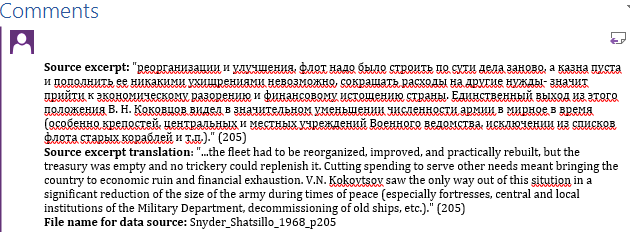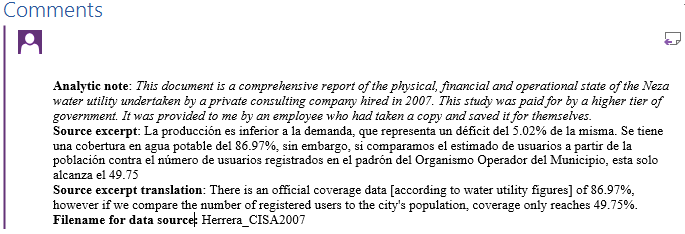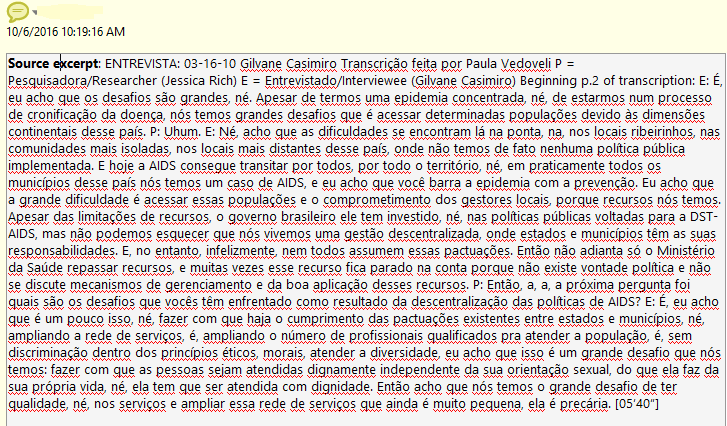This page offers instructions for preparing and depositing an “Annotation for Transparent Inquiry (ATI) Project” accompanying a digital manuscript. More information about ATI can be found here. ATI builds on Active Citation, an earlier approach to achieving transparency in qualitative research developed by Moravcsik (e.g., 2010, 2014, 2016). A detailed discussion of the intellectual logic underlying ATI can be found here.
An ATI Project is introduced by an “ATI Data Overview.” The bulk of the Project consists of a set of digital annotations containing analytic notes (discussing the generation and analysis of qualitative data and how they support textual claims/conclusions), source excerpts (and translations as needed), and the data sources themselves (when possible). In creating your ATI Projects, you will use Anno-REP, a new web application developed by QDR to streamline the creation of ATI Projects.
ATI Data Overview
The ATI Data Overview, of approximately 1,000 words in length, describes the research process in a holistic way. The Data Overview should not repeat information that is already included in the main text or notes of the manuscript; instead, use the Data Overview to supplement that information. If your manuscript has a bibliography or list of references, please include it in the Data Overview.
Typically, the Data Overview consists of three parts: (1) a description of the processes used to collect information and sources and to generate the data employed in the manuscript; (2) a description of how the data were analyzed to produce results; (3) an indication of the “logic of annotation” employed.
- Data generation: this part discusses and justifies decisions and choices you made in selecting, sampling and citing evidence, and considers the impact of those decisions and choices on the analysis. For instance, what instruments and procedures were employed to collect information and generate data? What relevant information was not or could not be consulted?
- Data analysis: this part offers an overview of how you analyzed the data and generated results, offering information beyond that offered in the manuscript about the analytic choices you made and why you made them.
- Logic of annotation: How did you choose particular passages of the manuscript for annotation? Where analytic notes are included, what is their main function (e.g., do they offer additional context, reflections, or interpretation; evaluate sources; or elucidate links between evidence and claims)? How did you decide which sources to provide and not to provide (e.g. were decisions based on sources’ accessibility, centrality to your argument, or the ethical or legal constraints they are under)?
The Overviews from these two QDR data projects serve as good examples:
- Samuel Handlin’sThe Politics of Polarization and
- Hillel Soifer’s “Elite Preferences, Administrative Institutions, and Educational Development.”
These are examples, not templates. The content and internal structure of your Overview should be appropriate for the manuscript and data it accompanies.
ATI Annotations
ATI Projects consist mainly of annotations. You can annotate any any in-text citation or or other textual passage. We recommend annotating passages of 3-5 words. Instead of annotating footnotes or endnotes, the words immediately preceding the note. QDR encourages you to accompany your annotations with as many of the data sources that underlie the passage in the text being annotated as possible, in particular if the sources are primary and/or hard-to-obtain.
Each annotation includes a combination of one or more of the following elements:
- A full citation to the underlying data source(s) mentioned in the annotated portion of the text (when a full citation was not included in the bibliography), and, where useful, additional location information;
- A source excerpt: typically 100 to 150 words from a textual source (e.g., an excerpt from the transcription for handwritten material, audiovisual material, or material generated through interviews or focus groups);
- A source excerpt translation: if the excerpt is not in English, a translation and indication of its source;
- An analytic note: discussion that illustrates how the data were generated and/or analyzed and how they support the empirical claim or conclusion being annotated in the text;
- Data source: the file name(s) of the corresponding data source(s) linked to the source(s) themselves when these are digital and can be shared ethically and legally.
You can annotate a manuscript using tools you are familiar with such as Word comments of PDF annotations or you can directly create them in QDR's Anno-REP tool.
Below are some examples highlighting various functions that annotations can serve. The examples are not exhaustive: you should use annotations in whatever way makes your research more transparent. Click on the thumbnails to open a full-size image of the annotation in a new tab.
Depositing an ATI Project to QDR: Anno-REP
Deposit your ATI Project through the Anno-REP tool. The tool will allow you to convert your Word or PDF annotations to Hypothes.is annotations; modify, add, and delete annotations; and link data files from an associated QDR data project. We provide detailed instructions for using Anno-REP.
Publishing with ATI
There are three strategies when approaching the journal submission and review process for a manuscript with ATI annotations. Authors of manuscripts with ATI annotations have used all three successfully.
-
Submit with a link to anonymised ATI Annotations: As you submit your manuscript through the journal’s submission system, you include a link to an anonymized, annotated manuscript on QDR modeled on the ATI data availability statement. Reviewers can then consult the annotated manuscript as well as associated data files. QDR curators will work arrange for the anonymized copy to be made available.
-
Submit the ATI annotations as a traditional supplement: Submit the complete list of annotations, including the text excerpts that they annotate as well as links to anonymized versions of any associated data files, as a traditional supplement through the journal’s submission system. QDR curators will assist you in obtaining the list of annotations as well as the anonymized data project and files (if applicable).
-
Don’t include ATI annotations in the peer review process: Since ATI is still a fairly novel approach, the annotations could distract or confuse reviewers, so you can choose to not mention them until an article’s conditional acceptance. This is analogous, e.g., to the common practive of quantitative researchers to only share data and code once an article is accepted for publication.
For the first two scenarios, we recommend you mention ATI in your cover letter to the journal’s editors. In the third scenario, you would bring up annotations in correspondence following the manuscript’s acceptance. We provide template language to use in correspondence with editors for your convenience.
Data Availability Statement
As you publish an ATI project (or if you follow the first option for peer review described above), we recommend that you include the following text in the first footnote or a comparable location. Journals will often be familiar with including such text under the label "data availability statement". QDR will provide you with the two links to include.
This paper uses Annotation for Transparent Inquiry (ATI), an approach to openness in qualitative scholarship. Access to the annotations, as an overlay to the digital article, can be found here: [Link] Access to a stand-alone copy of the annotations and underlying data are available here: [Link]


